Mythlogic Pollux 1613 / Clevo P157SM Review
by Jarred Walton on August 30, 2013 12:00 AM ESTMythlogic Pollux 1613 Overclocking
One of Mythlogic’s claims to fame with their Clevo-based notebooks is that they’ve customized the BIOS to allow overclocking. I haven’t tested any other Clevo P157SM/P177SM notebooks so I don’t know if they’re done a lot or if they just tweaked a few items, but you’re able to raise the maximum CPU multiplier. I’m not sure if there’s a different limit imposed by Intel, but for the i7-4700MQ we could increase the single-core, dual-core, multi-core multiplier by two bins (3.6GHz max) whereas on the i7-4900MQ we’re allowed to go up to four bins above the maximum single-core clock, so 4.2GHz for all settings. It’s worth noting that we were not able to run at 4.2GHz stably, and in fact I couldn’t get the Clevo P157SM to even boot into Windows. I didn’t do any intense research, but ultimately I found that setting the CPU to 4.0GHz for all loads ran without crashing, so that’s what I tested.
Before we get to the charts, there’s on other tidbit I want to discuss that relates to Haswell. With Sandy Bridge and Ivy Bridge – and pretty much every CPU I can recall testing over the past decade or so – I’ve found that best performance is achieved using the High Performance power profile. However, at one point in the testing of the Clevo P157SM I ran some tests on the Balanced power profile. In most cases the difference wasn’t anything noteworthy, and often the High Performance profile was indeed faster, but in some games the choice of Balanced actually improves performance quite a bit – GRID 2 being the main beneficiary. Our best guess is that with some titles, selecting High Performance tries to run all the CPU cores at maximum clocks and may end up lowering the maximum Turbo Boost multiplier. With GRID 2, at our Value settings the Balanced profile ended up 15% faster, and even at our Mainstream settings there was still an 8% increase in frame rates (though this went away at the Enthusiast settings).
I mention this because all of the initial testing with overclocking and stock CPUs was done using the High Performance profile. I could go back and rerun every test on the Balanced profile to investigate the topic more, but that’s a lot of hours of running repetitive benchmarks for a relatively small payoff, and I’ve already benchmarked the P157SM far more than any other notebook in recent history. If the High Performance profile is indeed causing maximum Turbo Boost clocks to drop slightly because of increased heat, however, overclocking may further exacerbate the problem. If you end up buying one of these notebooks, I’d suggest at least looking at how the Balanced vs. High Performance profiles affect the games and applications you use. Of course, for laptops that I actually use, I tend to just stick with the Balanced profile as a good blend of battery life when I’m unplugged and performance when I’m plugged in, but it is an interesting change with Haswell regardless – possibly brought about by the integrated voltage regulator? Anyway, on with the overclocking benchmarks.
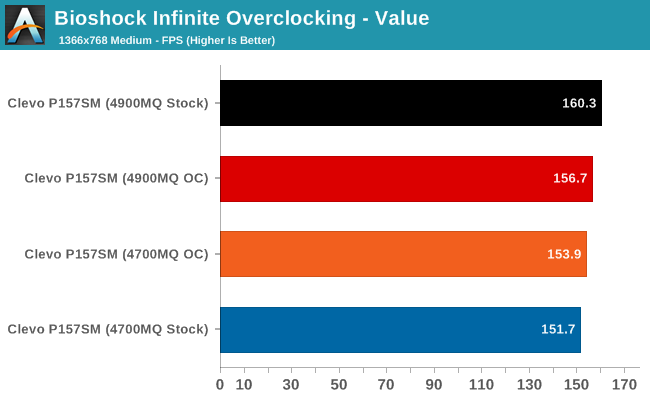
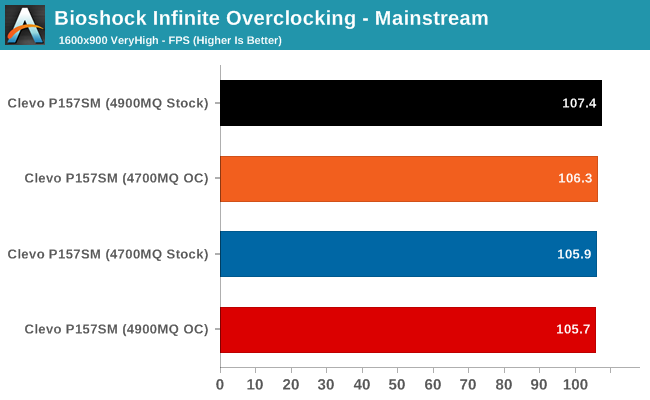
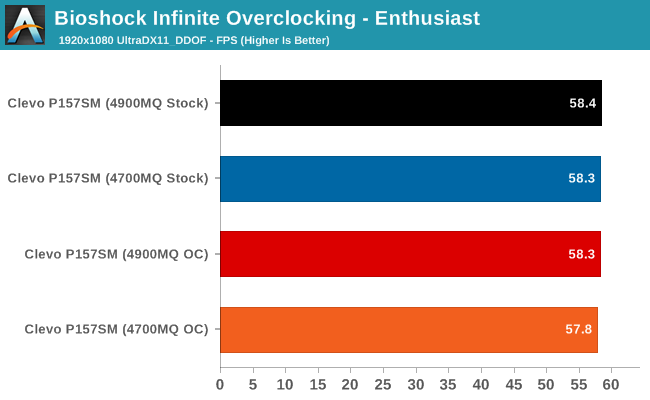
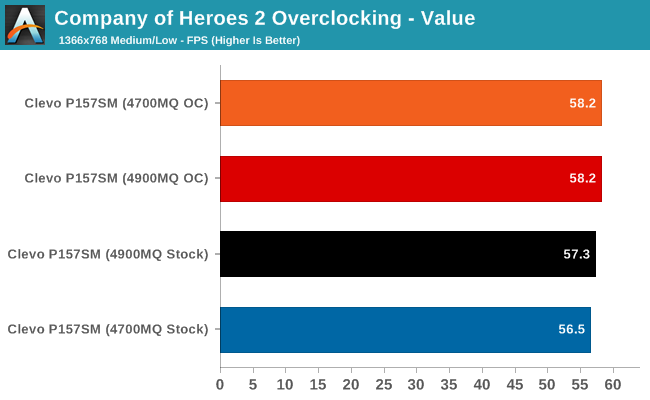
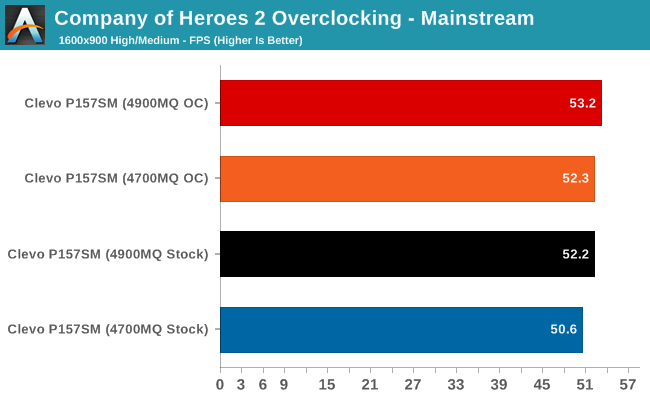
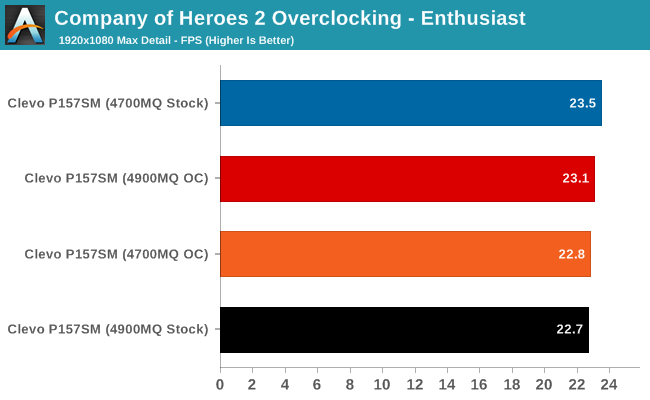
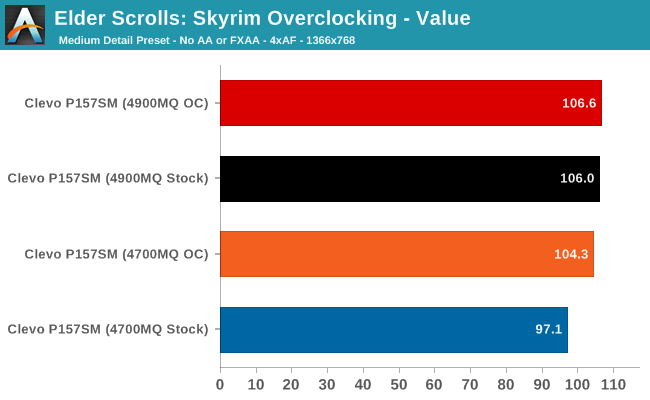
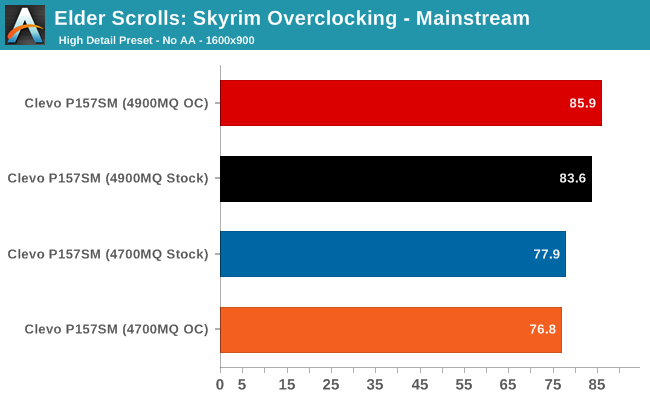
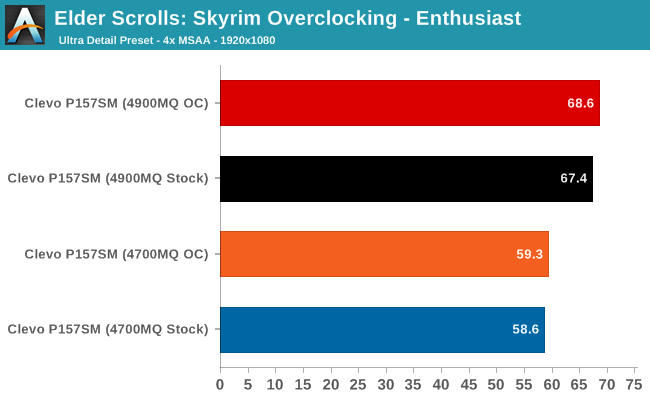
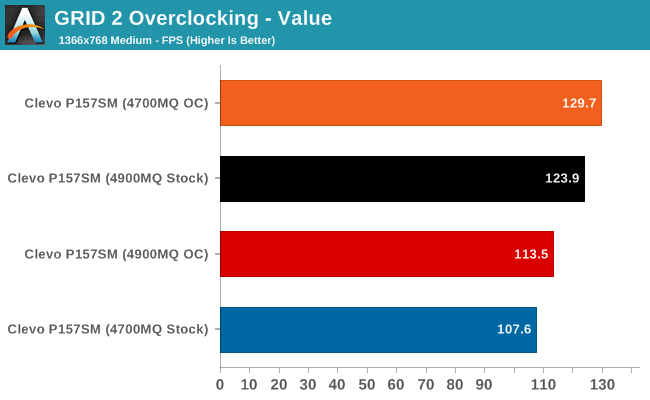
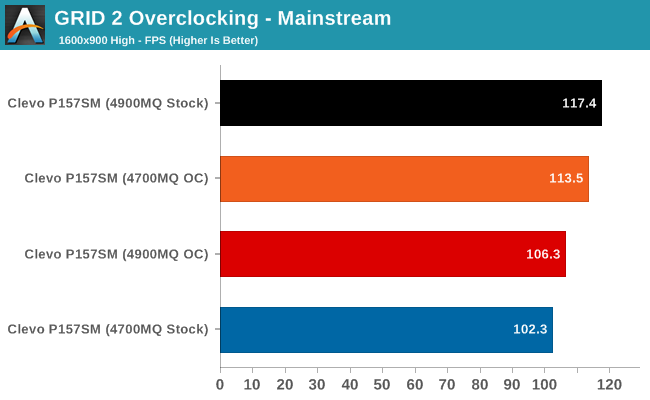

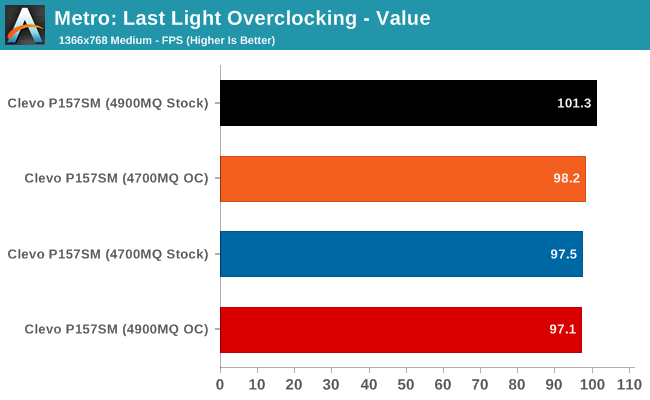
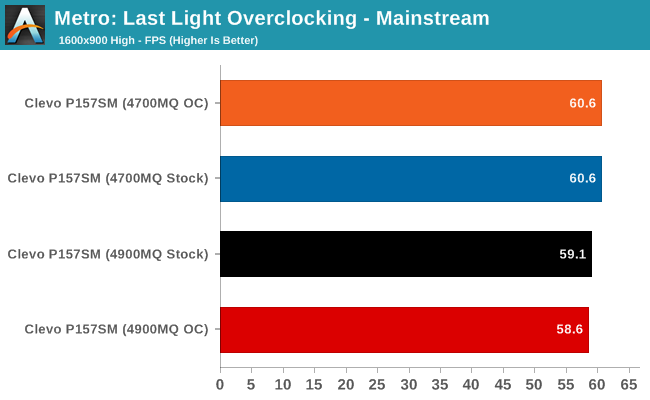
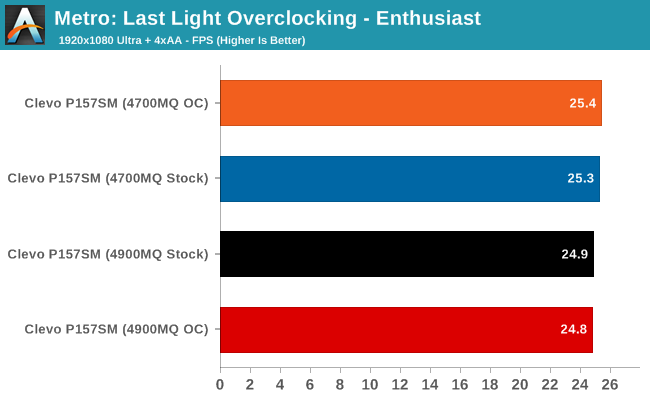
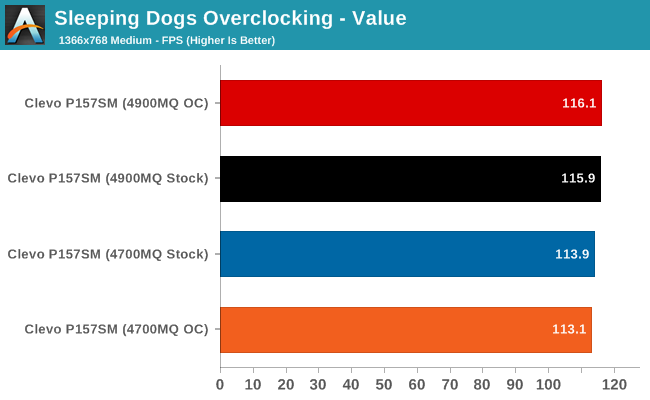
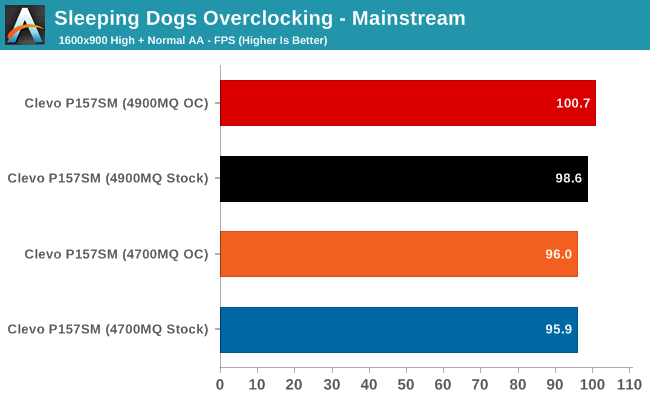
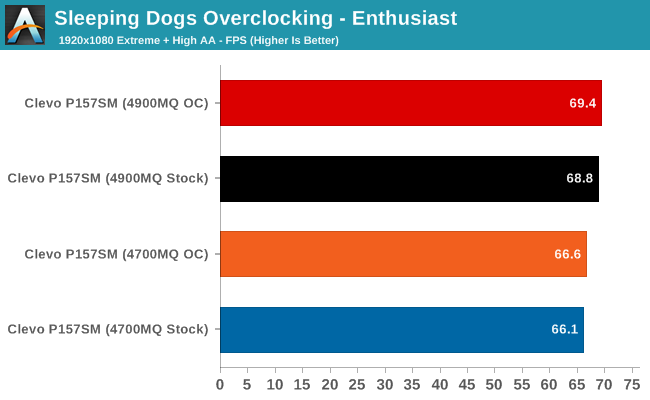

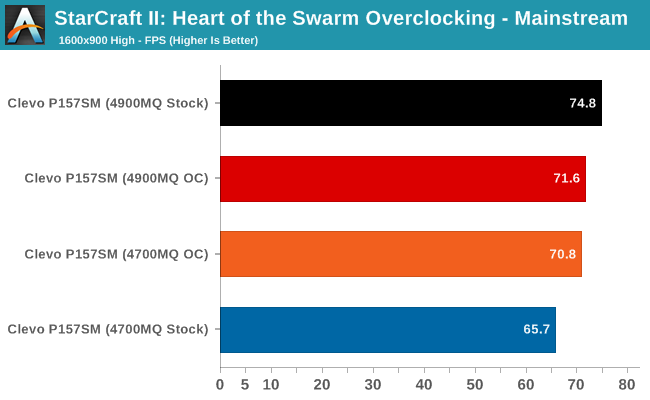
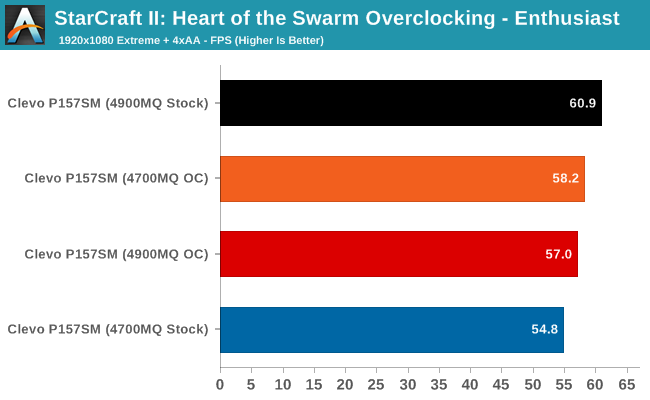
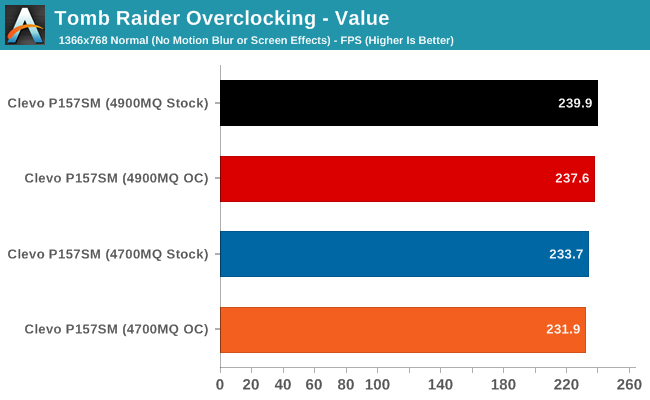
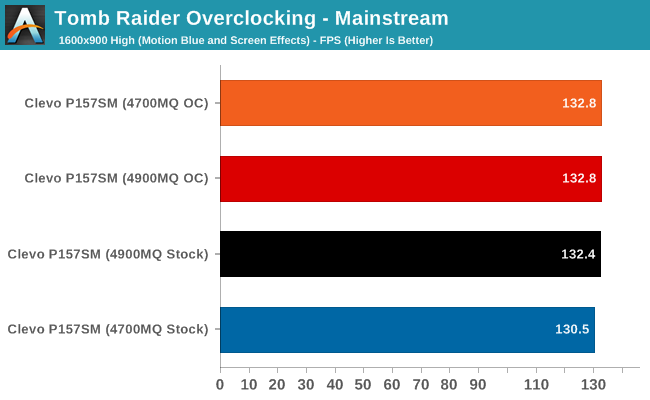

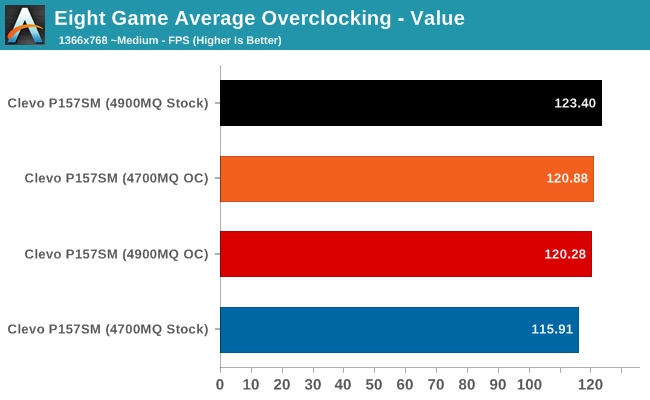
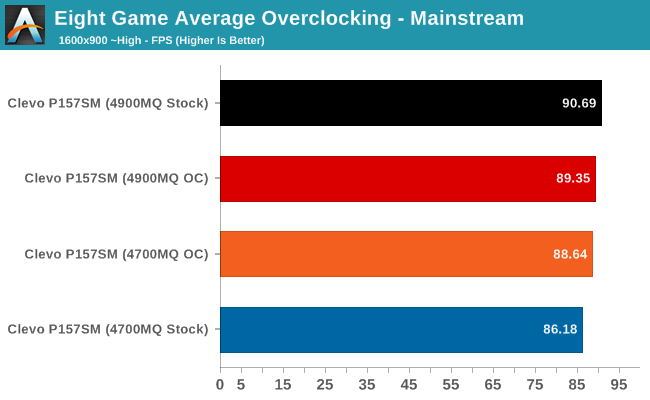
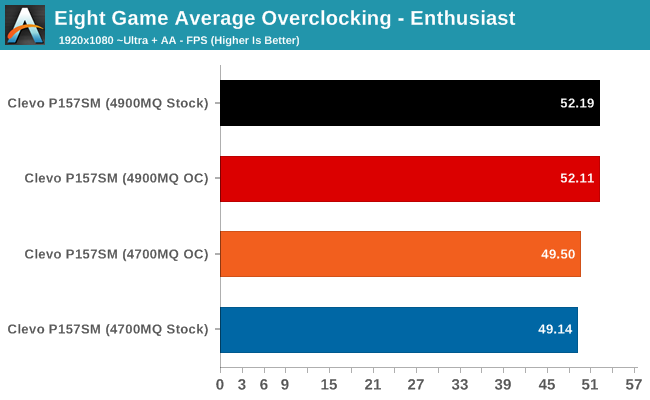
The same titles that benefit the most from the CPU upgrade should likewise benefit from overclocking. Skyrim, GRID 2, and StarCraft II apparently love having faster CPUs… but in practice, the gains from overclocking the CPU are small at best. The 4900MQ actually shows what I was talking about with the higher maximum clocks potentially ending up slower on average compared to the stock 4900MQ. In the end, the 4700MQ benefited more from overclocking than the 4900MQ, but perhaps with a bit more tuning I could coax the 4900MQ higher – like limiting the clocks to 4.0/3.9/3.8/3.7GHz for single/dual-triple/quad loads instead of setting them all to 4.0GHz. The short summary is that on average the stock 4900MQ is around 5-7% faster than the stock 4700MQ, while the overclocked 4900MQ is only 1-5% faster (and sometimes slower) than the overclocked 4700MQ.
Overall changes from overclocking the 4700MQ are anywhere from -3% to +8%, with larger changes at Value and Mainstream settings; the average change is +0.7% at Enthusiast, and +2% at Value and Mainstream. Overclocking of the 4900MQ shows changes ranging from -10% to +3%; GRID 2 and StarCraft II both drop in performance by more than 5%, so further tuning would be required to find a good balance. The 2-bin overclocking limit of the 4700MQ also prevents it from fully closing the gap with the stock 4900MQ, but it does get a bit closer.
There’s obviously a second question that I haven’t even touched on with regards to overclocking: can we get any additional performance out of the GTX 780M? Personally, with the GPU already hitting 85C under normal gaming use, I’m not inclined to push it harder. This is an expensive notebook with a very fast GPU, and until we get even higher resolution displays there’s really not much need to overclock the GPU. Others are welcome to do so, and I know some have already done so and posted results, but if I purchased a notebook like this I wouldn’t want to risk damaging a chip for a few more FPS.










47 Comments
View All Comments
rpgfool1 - Saturday, August 31, 2013 - link
They do sound like reasonable tradeoffs. I might as well get the P170SM or P177SM then. Now to look at Clevo resellers that has reasonable prices...GTVic - Saturday, August 31, 2013 - link
I doubt you can connect AC power to the back as listed in the spec on page 1, there must be a power brick, which according to a quick search may weigh as much as 1.8lbs. The size and weight of that should be listed in the specs since you are definitely going to have to cart that around.MDX - Saturday, August 31, 2013 - link
I'm tired of the hideous and fat clevo cases. If I wanted a fat gaming laptop, the alienwares have way better styling. If I wanted a slim gaming computer, the razers have way better styling. I'm not going buy a somewhat-chunky, black ugly laptop, regardless of hardware...rpgfool1 - Saturday, August 31, 2013 - link
Don't people experienced problems with Alienware notebooks though? The Razer Blade and the Razer Blade Pro look very nice, almost like a Macbook Pro in design. Macbook Pros look very nice and sleek, but people pay for the Apple brand name. I don't know why premium PC notebooks get stuck with 1920 x 1080p screen when Macbook Pros are able to get 2560 x 1600 or 2880 x 1800 on 15" screens? I know they cost more and the panels are probably IPS.MDX - Monday, September 2, 2013 - link
Not sure about Alienware, but I have an XPS M1730 (dell's gaming line before they bought alienware) that lasted almost 6 years. I'm only now in the market for a new machine because of that, and it seems my only option is still the same size/formfactor as it was 6 years ago: fat and heavy. I was hoping to get something slimmer with some style that was still user-serviceable, but I can't, so I'm building a desktop instead.Razer's compromise on the screen, plus non-user serviceable hardware rules that out, and the alienware laptops just aren't portable. These clevo machines are too ugly and have too low resolution, MSI's new GS70 is also ugly and not innovate (except for the slimness) so that leaves me with nothing that entices me to spend money on it.
If Razer would put a panel that does justice to their blade pro and ditched the chiclet keyboard (I can't stand chiclet keyboards), I'd be all on it!
woofblitzer - Saturday, August 31, 2013 - link
First off, let me thank you for your review. I have been EXTENSIVELY researching the Clevo P157SM and as Sager puts it with the improved 95% matte display NP-8255-S. It's just that damn tramp stamp...can that be removed and replaced? No reseller really looks to replace it, they all have it on their pages...(funny that they all price out to $2489 too...who is really making these behind the scenes that all sites price the same). I had been wondering about thermal issues and you mention the MSI series. I really really like the MSI 16F4 barebones, not quite cosmetically but comparable to the MSI GT60 2OD....the MSI barebones just looks better to me...but with your testing results of MSI products, are you predicting the MSI barebone will perform like it's parent? I cannot find any real review of the MSI 16F4 anywhere. I would much rather go with the MSI for looks and sound, but it seems the Clevo is cooler and for some reason runs benchmarks and Windows Experience Index faster, even when equipped with the same equipment.JarredWalton - Saturday, August 31, 2013 - link
The only thing that might help the barebones MSI (or any of them) is if you put on better thermal grease, but that's a stretch to drop temperatures 10C. As for the tramp stamp, Mythlogic says they'll replace the backlit cover with a non-backlit option; you'll have to call and request it, though, as it's not listed in the online configurator. Other vendors might be willing to do something similar; I don't know. Hope that helps.DanNeely - Saturday, August 31, 2013 - link
Is that different from just disabling the trackpad backlight, which they do have as an option in the configurator.woofblitzer - Saturday, August 31, 2013 - link
Any theories on while similar equipped Clevo and MSI bare bones, why the Clevo seems to score a little higher? Is it driver or hardware related? Also, would you know, two questions...on the P157SM, if you get an msata, does in only fit in the HDD slots being fitted with the 2 x mstata adaptor or can you go say two msata and two ssd in the HD space? Maybe it is only having a third msata that breaks into HDD space? One last question since you have tested the closest to what I am looking at, but would you assume MSI bare bones do not come with the cooler and turbo boost that the non barebones come with? Ok, promise, one last question...if I am looking towards the future...should I be looking more at the P177SM, because I could add a second GPU someday or is the secondary GPU market pretty non existent outside ebay?rpgfool1 - Saturday, August 31, 2013 - link
You can't even add a 2nd GPU in the P177SM. The P370SM and P375SM have the option of Crossfire or SLI 2 mobile GPUs.